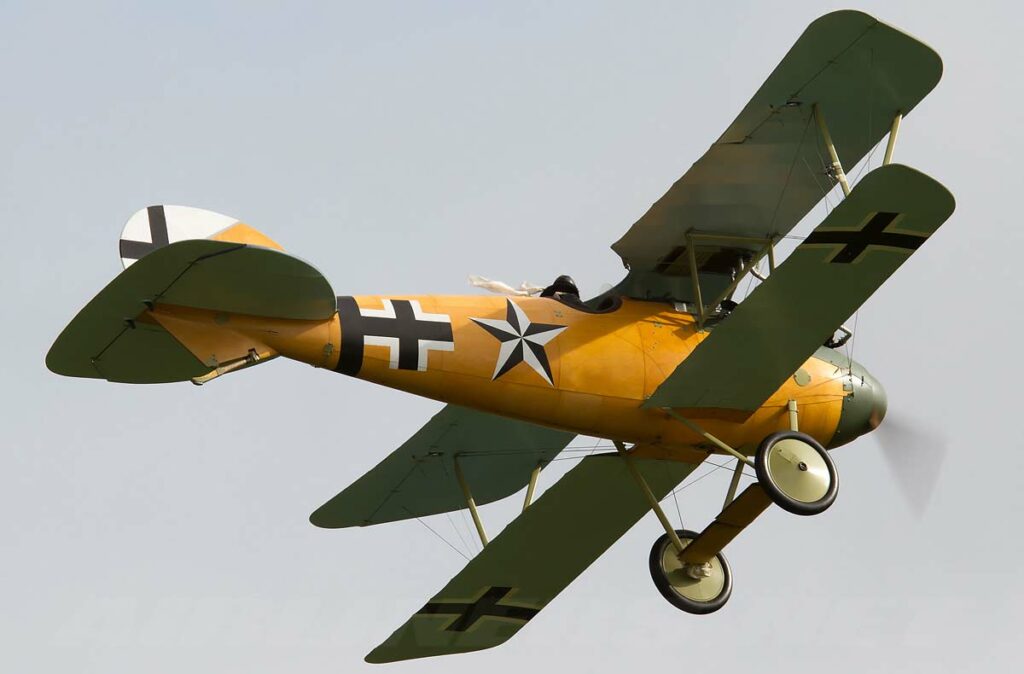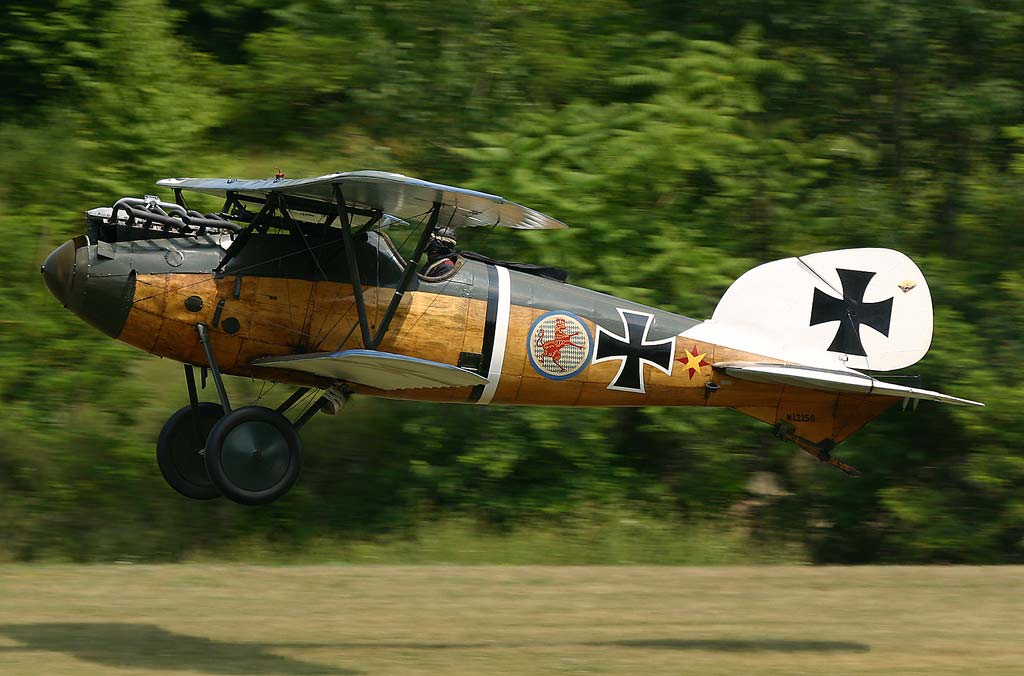The Albatros D.Va, a German biplane fighter of WWI, was known for its Mercedes D.IIIa engine, twin LMG 08/15 guns, and distinctive sesquiplane design. This article examines the Albatros D.Va, a German biplane fighter from WWI. Covering its development history, design features, performance capabilities, and military usage, the article provides an in-depth analysis of this iconic aircraft.
The Albatros D.Va was a significant fighter aircraft used by the German Empire during World War I. Known for its combat prowess and distinctive design, it played a critical role in aerial engagements of the era.

History of the Development of the Albatros D.Va
The Epoch’s Context
The Albatros D.Va was developed during a time of rapid advancements in military aviation. World War I saw a transition from the use of aircraft for reconnaissance to their employment as powerful tools in aerial combat.
Developmental Need
Germany’s need for an advanced fighter aircraft arose from the increasing sophistication of Allied fighters. The success of earlier Albatros models necessitated an improved version to maintain air superiority.
Development Objectives
The main objectives were to enhance speed, maneuverability, and armament over previous models, addressing the shortcomings faced in combat against increasingly competent Allied aircraft.
Program Launch
The Albatros Flugzeugwerke, led by designers like Robert Thelen, launched the development of the D.Va variant in response to evolving warfare demands.
First Flight
The Albatros D.Va first flew in 1917, quickly transitioning from prototype to production due to urgent wartime needs.
Design of the Albatros D.Va
Technical Specifications
Length: 7.33 m (24 ft 1 in)
Wingspan: 9.05 m (29 ft 8 in)
Height: 2.59 m (8 ft 6 in)
Wing area: 20.5 m² (220.66 ft²)
Powerplant
Engine: Mercedes D.IIIa, 6-cylinder water-cooled inline engine
Power: 180 hp (134 kW)
Design Advantages
The D.Va’s sesquiplane design, featuring a larger upper wing and smaller lower wing, provided improved climb rate and visibility for the pilot. The streamlined fuselage enhanced aerodynamics, contributing to better speed and handling.
Drawbacks
Despite improvements, the D.Va struggled with structural weaknesses in the lower wings, leading to in-flight failures. Its performance at high altitudes was also inferior to some Allied aircraft.
Contribution to Aircraft Development
The Albatros D.Va influenced later biplane designs, particularly in its streamlined fuselage and the balanced placement of armament.
Performance of the Albatros D.Va
Engine and Power
The Mercedes D.IIIa engine was reliable and provided a good power-to-weight ratio for the time, but it was gradually outclassed by more powerful Allied engines.
Speed, Altitude, and Range
Maximum Speed: 186 km/h (116 mph)
Service Ceiling: 5,500 m (18,044 ft)
Range: 350 km (217 miles)
Comparative Analysis
Compared to contemporaries like the Sopwith Camel and the SPAD S.XIII, the Albatros D.Va was less agile but provided a stable gun platform. Its performance was competitive initially but fell behind as Allied aircraft designs rapidly advanced.

Military Use and Combat of the Albatros D.Va
Armament
The D.Va was equipped with twin LMG 08/15 machine guns, providing effective firepower in dogfights.
Combat Use of the Albatros D.Va
Deployment on the Western Front
The Albatros D.Va was extensively deployed on the Western Front, where it served as one of the primary German fighter aircraft. This theater of war, characterized by extensive trench networks and a constant need for aerial reconnaissance and supremacy, was where the D.Va demonstrated its combat effectiveness.
Air Battles and Dogfighting Prowess
The aircraft’s role in numerous air battles was pivotal. It excelled in dogfighting, primarily due to its stability as a gun platform and its effective diving capabilities. These attributes allowed German pilots to engage in aggressive combat tactics, often initiating attacks with a high-speed dive onto unsuspecting Allied aircraft.
Tactics and Engagements
German pilots, leveraging the D.Va’s strengths, often used altitude and the element of surprise to their advantage. The aircraft’s structure, particularly its sturdy, well-designed wings, allowed pilots to execute steep dives and rapid changes in altitude during combat. This capability was crucial in both offensive maneuvers and evasive actions.
Encounters with Allied Fighters
The Albatros D.Va regularly clashed with the foremost Allied fighters of the time, including the Sopwith Camel, the Nieuport 17, and the SPAD series. While the D.Va was less maneuverable than some of its adversaries, its combination of speed, firepower, and diving ability enabled it to hold its own in these encounters.
Impact on Aerial Engagements
The Albatros D.Va’s combat style often dictated the nature of aerial engagements over the Western Front. Its presence in the skies forced Allied pilots to develop new tactics and strategies, leading to a continuous evolution of aerial combat techniques during the war.
Limitations in Combat
Despite its strengths, the Albatros D.Va was not without limitations. Its lower wing was prone to structural failure, particularly during high-speed maneuvers and prolonged dives, which sometimes led to catastrophic outcomes. Moreover, as the war progressed, newer Allied aircraft began to outperform the D.Va in various aspects, particularly in terms of speed and high-altitude performance.
Role in Key Battles
The Albatros D.Va was involved in several key aerial battles of World War I. Its contribution to these battles often involved not only engaging enemy fighters but also escorting reconnaissance and bombing missions, protecting them from Allied interceptors.
Legacy in Combat
The combat use of the Albatros D.Va during World War I significantly impacted the tactics and development of fighter aircraft. Its design influenced subsequent German fighters, and its operational history provided valuable lessons in aircraft engineering and air combat strategy. While eventually overshadowed by more advanced designs, the D.Va’s role in shaping the early years of aerial warfare is undeniable.
Competing Aircraft
It primarily contended with the Sopwith Camel, SPAD S.XIII, and the Nieuport fighters.
International Use and Service End
While primarily used by Germany, a limited number were captured and used for evaluation by the Allies. The Albatros D.Va was eventually replaced by more advanced aircraft such as the Fokker D.VII.
The Albatros D.Va, with its distinctive design and combat performance, marked an important chapter in the history of military aviation during World War I. Despite some limitations, its impact on aerial warfare and influence on future aircraft designs remain significant.
Back to the Warbirds section.